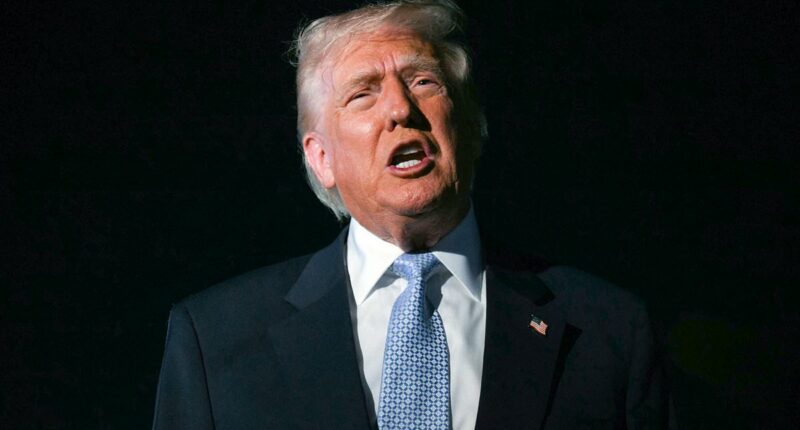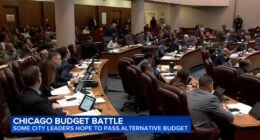Share this @internewscast.com
On Sunday evening, former President Donald Trump clashed with a reporter who challenged him over his support for Tucker Carlson following Carlson’s contentious interview with Nick Fuentes.
The interview, released in October, featured Carlson and Fuentes—a known far-right figure—discussing U.S.-Israel relations. Fuentes, 27, has gained notoriety for his anti-Semitic comments, including making light of the Holocaust.
Since its release, the interview has sparked controversy, amassing over 18 million views on the platform X. The discussion has drawn criticism from conservative leaders, with numerous Republican lawmakers condemning Carlson for giving Fuentes a stage.
Despite the backlash, Trump came to Carlson’s defense and even spoke positively about Fuentes. Trump had previously hosted Fuentes for Thanksgiving dinner in November 2022 at his Mar-a-Lago estate.
“Well, I found [Tucker] to be good. I mean, he said good things about me over the years. I think he’s good. We’ve had some good interviews,” Trump remarked.
His comments were abruptly interrupted by a reporter, prompting Trump to snap, “Will you let me finish my statement? You are the worst! You’re with Bloomberg, right? You are the worst! I don’t know why they even have you.”
Trump resumed his statement defending Tucker by adding, ‘You can’t tell him who to interview. I mean, if he wants to interview Nick Fuentes, I don’t know much about him, but if he wants to do it, get the word out. People have to decide. Ultimately, people have to decide.’
A reporter followed-up by asking Trump about his dinner with Fuentes in 2022. The president noted that he ‘didn’t know he was coming’ because he came along with rapper Kanye West.

Donald Trump defended Tucker Carlson amid the fallout from his controversial interview with far-right activist Nick Fuentes

Carlson and Fuentes sat down for an interview released in October, leading to condemnation from the country’s top conservative leaders

Fuentes responded to Trump’s defense by thanking the president to his 1 million followers on X
‘Well, I didn’t know he was coming and he was with, as you know, somebody, Kanye. And Kanye asked if he could have dinner and he brought Nick. I didn’t know Nick at the time.’
Trump hosted a Thanksgiving dinner with West and Fuentes amid the rapper’s series of anti-Semitic remarks. At the dinner, West allegedly floated the idea of running for president with Trump serving as a vice presidential nominee.
The suggestion by West reportedly led to Trump becoming frustrated by the rapper and the dinner ended shortly after.
Trump added, ‘And he did. He came along with a few other people. He brought a few people with him.’
‘Meeting people, talking to people like for somebody like Tucker, that’s what they do. You know, people are controversial. Some are, some aren’t. I’m not controversial, so I like it that way.’
Trump’s dinner with Fuentes and West led to widespread condemnation from GOP leaders, including former Vice President Mike Pence who bashed Trump for giving ‘a white nationalist, an anti-Semite and Holocaust denier, a seat at the table.’
Trump defended his decision at the time by claiming he knew ‘nothing about’ Fuentes, but did not disavow him.
Fuentes responded to Trump’s new remarks on Sunday evening by thanking the president on X to his 1.1 million followers. ‘Thank you Mr. President!’ he wrote.

Fuentes dined with Trump and rapper Kanye West in November 2022 at the Mar-a-Lago estate

Tucker Carlson has been a vocal right-wing critic of the Trump administration’s foreign policy
Fuentes’ popularity has soared this year and he has been interviewed by some of the most prominent internet media personalities, including Tucker Carlson, Glenn Greenwald and Candace Owens.
Carlson’s decision to interview Fuentes sparked a backlash among conservatives over the white nationalist’s anti-Semitism and statements on Israel’s war in Gaza.
In the past, Fuentes has been critical of Trump and encouraged his supporters, known as ‘Groypers’, not to support Trump in the 2024 election.
Trump’s defense of Carlson and Fuentes comes after his administration has threatened to pull funding for universities and colleges for allowing pro-Palestinian protests amid the Israel-Hamas war.
Carlson has been a vocal critic of the Trump administration’s foreign policy, including over the president’s apparent desire for regime change in Venezuela.





